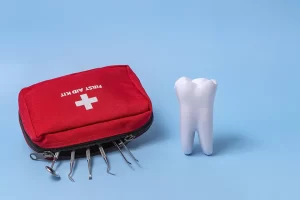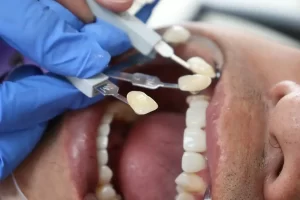If you’re worrying about breath right before a meeting or a school pickup, you’re not alone. At FIFTH ST Dental in Etobicoke, we see this every week. The fix isn’t a stronger mint—it’s understanding the causes of bad breath and tackling them in the right order. For most people, the causes of bad breath are a mix of plaque, a coated tongue, dry mouth, and sometimes non-oral factors like sinus drip or reflux. Once we find your main driver, improvement comes quickly.
Causes of Bad Breath: Where Odour Really Starts
Halitosis is usually local. Bacteria break down food proteins and release sulphur compounds. If plaque sits along the gumline, food lodges between teeth, or the tongue stays coated, you’ll notice it. Low saliva lets odour concentrate. The upside: each factor is findable and fixable with a clear plan.
The Oral Drivers You Can Change (With Simple Wins)
- Plaque at the Margins: A 45° brush angle against the gumline matters more than brushing harder. That’s where the biofilm lives—and where many causes of bad breath begin.
- Tongue Build-Up: The back third of the tongue traps shed cells and bacteria. A 10-second scrape once a day often delivers the biggest early win.
- Gum Inflammation: Bleeding when you floss isn’t “normal.” Inflamed pockets shelter odour-producing bacteria. Treating gums reduces VSCs at the source.
- Hidden Traps: Food catches under overhanging fillings, crowded contact points, or a loose denture clasp. Smoothing or repairing these removes a constant trigger.

When It's Not Only the Mouth
- Dry Mouth: Common with antihistamines, antidepressants, and blood-pressure meds. Less saliva means less buffering and more odour.
- Postnasal Drip & Reflux: Protein-rich mucus and acid backflow alter pH and coat surfaces—fuel for bacteria.
- Lifestyle: Tobacco dries and irritates tissues; frequent alcohol use has a similar effect. Very low-carb diets can change breath temporarily.
- Medical Links: Uncontrolled diabetes and some systemic conditions can shift breath character. If we suspect this, we loop in your physician.
How We Find Your Causes of Bad Breath
- Health & Habit Review: Meds, hydration, snoring or mouth-breathing, reflux symptoms, diet pattern.
- Gum/Tooth/Tongue Exam: We check plaque levels, pocket depths, tongue coating, decay, and leaky margins.
- Targeted Imaging (if needed): Small X-rays pick up hidden decay and bone changes around inflamed sites.
- Plain-English Plan: We list your top causes of bad breath and the steps—home and in-office—that will actually move the needle.
Daily Routine That Works
- Brushing: Two minutes, twice daily, bristles angled toward the gumline. Electric brushes help with consistency; manual is fine if the angle is right.
- Between Teeth: Interdental brushes where they fit, and floss elsewhere. Water flossers are helpful add-ons—not full replacements.
- Tongue: Gentle scraper, back to front, once a day. If you gag easily, aim for a few shorter strokes.
- Hydration & Saliva Support: Keep water nearby; sugar-free xylitol gum boosts flow. Night mouth-breathing? Try a bedside humidifier.
- Rinse (Smartly): Alcohol-free options with zinc or CPC neutralize odour without drying tissues.
Causes of Bad Breath: In-Office Care That Resets the Baseline
- Professional Cleaning: Removes calculus that toothbrushes can’t budge and drops bacterial load fast.
- Periodontal Therapy: Deep cleaning reduces pocket depths and inflammation, the stubborn core of many causes of bad breath.
- Restorative Fixes: Replace leaky fillings and treat cavities to remove food traps you can’t reach.
- Fit & Form Tweaks: Smoothing rough edges on crowns or refining a partial denture fit prevents debris from sticking.
- Managing Dry Mouth: Fluoride varnish, remineralizing gels, saliva substitutes, and—when appropriate—medication reviews with your physician.
Food, Drink, and Everyday Choices
- Don’t Skip Breakfast: Water plus food helps clear overnight coating.
- Crunch + Fibre: Apples, carrots, and leafy greens add a gentle scrub and dilute odour compounds.
- Coffee/Tea/Wine Fans: Quick water rinse after sipping keeps residue off the tongue.
- Cutting Back Helps: Less tobacco and alcohol typically means less dryness—and less odour.
- If Reflux or Sinus Is Active: Medical treatment here often changes the breath story more than anything else.

Causes of Bad Breath: What Improvement Looks Like
Follow a targeted plan, and most people notice fresher breath within one to three weeks. If odour rebounds an hour after brushing, you see bleeding when flossing, or your tongue re-coats quickly, book an exam. Those are signs that an underlying cause of bad breath—like gum disease, hidden decay, or true dry mouth—needs treatment.
A Practical Next Step
If you’re ready for results that last, schedule a visit at FIFTH ST Dental in Etobicoke. We’ll identify your specific causes of bad breath, clean up the root issues, and leave you with a routine that’s simple enough to keep.
FAQs — Causes of Bad Breath
Why does my breath smell again shortly after brushing?
Because brushing handles enamel, not everything else. If plaque between teeth, tongue coating, or gum inflammation remains, the causes of bad breath are still in play. Add interdental cleaning and tongue care, and improvement lasts.
Do tongue scrapers really help?
Yes. A quick daily scrape reduces the bacterial load behind most odours. It’s one of the most efficient fixes for the causes of bad breath we recommend.
Can cavities or old fillings be to blame?
They can. Open margins and decay trap food and bacteria. Repairing them removes a hidden source and makes your home care far more effective.
What if my medications dry my mouth?
Hydrate regularly, use xylitol gum or lozenges, choose alcohol-free rinses, and ask us about saliva substitutes. Addressing dryness tackles a major contributor to bad breath.





